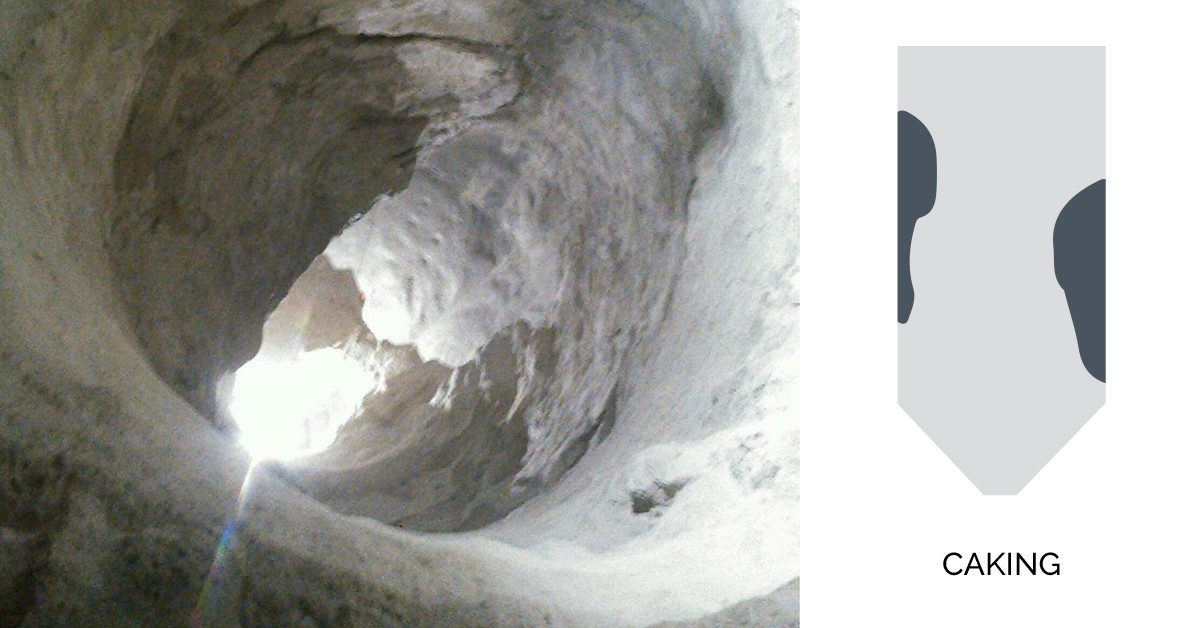Blog
CATEGORIES
Is your silo plugged?
Storage silos are used in almost every industry to store materials safely until they are needed for use, but no matter the design or the materials stored, silos are susceptible to material flow issues caused by blockages.
Blockages not only lead to a reduced storage capacity and disrupted or slowed operations, they also promote bad flow characteristics. When material flow is off, delamination, exterior concrete cracking and structural failure can result. There are numerous blockage types possible in storage silos, two common flow issues are bridging or caking.
If there is a blockage and your silo is plugged, here's how to know whether it's related to bridging or caking.
Bridging
 When material is poured into the storage silo it exerts pressure on the material under and around it, and with some materials, this surrounding pressure can cause a structural bond. This bond results in a bridging effect, where the bottom of the bridge empties but a dome arch remains, preventing any further material from flowing. As more material is dumped on top of the bridge the pressure exerted increases and the bonds holding the bridge together will actually become stronger.
When material is poured into the storage silo it exerts pressure on the material under and around it, and with some materials, this surrounding pressure can cause a structural bond. This bond results in a bridging effect, where the bottom of the bridge empties but a dome arch remains, preventing any further material from flowing. As more material is dumped on top of the bridge the pressure exerted increases and the bonds holding the bridge together will actually become stronger.Caking
 Caking occurs when powder, such as detergents, fertilizers and salts, become cohesive after storage, forming agglomerates comprised of individual particles that are bonded together. Caking results when the magnitude of interparticle forces increase over time. The most common cause of caking is moisture migration due to temperature changes with materials that are soluble. Caking creates resistance to flow in silos and can result in residue on walls.
Caking occurs when powder, such as detergents, fertilizers and salts, become cohesive after storage, forming agglomerates comprised of individual particles that are bonded together. Caking results when the magnitude of interparticle forces increase over time. The most common cause of caking is moisture migration due to temperature changes with materials that are soluble. Caking creates resistance to flow in silos and can result in residue on walls.You can help reduce the likelihood of material build-up through a number of ways, click here to watch and learn more. Depending on how easily stored material compacts or hydrates, your silo may need to be completely emptied on a regular schedule as often as once a month or as little as every year.
Silos that are regularly emptied and refilled are less likely to experience build-up issues than in those kept topped off. Regularly emptied silos need professional cleaning less frequently in comparison. They are also less likely to experience issues like compacting and hydrating. Hydration occurs when moisture mixes with stored materials and causes them to solidify within the silo. When this happens, materials can expand and cause added wall pressure, increasing the likelihood of structural failure.
The routine examination of your silo is only effective in increasing facility safety and ensuring smooth operations when it is conducted in conjunction with professional cleaning and inspection services as part of a regular preventive maintenance schedule.
Whether you have bridging, caking or plugging of any stored material, it’s essential to contact USA Silo Service, a division of the Marietta Group, which includes Marietta Silos and Marietta Inspection Services, to have the build-up removed quickly. This recent case study shows USA Silo Service using their proprietary equipment and cleaning methods to remove coal build-up in a silo and greatly improve material flow.
To learn more, be sure to check out our full library of silo inspection videos on silo maintenance, inspection and repair on our  .
.





